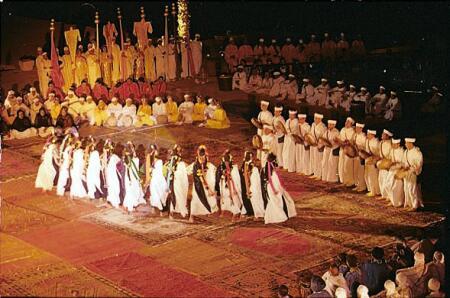Music and dance are an integral part of Moroccan life. During a trip to Morocco, you may witness processions of dancing villagers parading through the streets, or you might be kept awake late at night by the sound of rhythmic drums and the piercing ululations of wedding celebrations. While music and dance in Morocco can usually be categorized as indigenous Berber or classical Arab, you will also see and hear African, European and Jewish influences in these traditional art forms.

Ghiaytas
Ouais
 Described as a mixture of English ballet and classical Arabic music, the ouais is a graceful, fluid dance performed by women. The dancers wear copper cymbals on their fingers and are dressed in elaborately embroidered kaftans with silk belts. Most often performed at weddings, the ouais dance is accompanied by a one-stringed fiddle, two or three small mandolins and the simple rhythm of one musician pounding on a large piece of cast iron.
Described as a mixture of English ballet and classical Arabic music, the ouais is a graceful, fluid dance performed by women. The dancers wear copper cymbals on their fingers and are dressed in elaborately embroidered kaftans with silk belts. Most often performed at weddings, the ouais dance is accompanied by a one-stringed fiddle, two or three small mandolins and the simple rhythm of one musician pounding on a large piece of cast iron.Ahidou
A dance of the Middle Atlas Berbers, the ahidou is performed by both men and women. All dancers stand in a circle, and their songs are lyrical and poetic. In addition to their matching blue cloaks with white stripes, the women are adorned with jewelry made of yellow amber beads and skillfully engraved silver. The men wear sleeveless, hooded gowns known as burnooses and have turbans tied on their heads. Some troupe members play tambourine while others sway and clap to the music.
Houara
The houara dance of Inezgane is also a mixed gender folk dance, but the performance troupe includes several men and only one woman. All dancers form a tightly packed circle and take turns coming in to the middle to show off intricately choreographed routines. One man may come in to the circle alone, or two men may come in to the circle together. As the tempo speeds up, the woman rushes into the center of the circle to end the dance. The houara has traditionally been used as a spiritual folk dance by Berber tribes.

